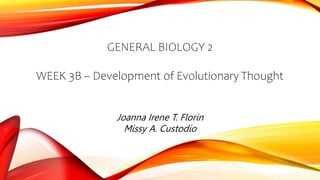
GenBio - FLORIN & CUSTODIO (1).pptx
- 1. GENERAL BIOLOGY 2 WEEK 3B – Development of Evolutionary Thought Joanna Irene T. Florin Missy A. Custodio
- 2. During the classical times, many ancient scientists believed that all species on earth were unchangeable based on the concept of essentialism (Winsor, 2003). Their main argument was that if the creations of God were perfectly crafted, why then would God fix or change it?
- 3. Carolus Linnaeus (1707 - 1778) - known as the “Father of Taxonomy”, a Swedish botanist, who took up the new idea that plants reproduced sexually, using differences in reproductive structures to develop a system for classifying /naming plants. In the year 1735, he published his work, Systema Naturae (“System of Nature”), which introduced the hierarchical taxonomic categories: Kingdom-Phylum- Class-Order-Family-Genus-Species. His research gave all his specimens a descriptive Latin binomial, or two-word, name. Thus, all modern classification systems have their roots in Linnaeus’ system.
- 4. Thomas Robert Malthus (1766 – 1834) - An English cleric, scholar and influential economist within the fields of economics and demography. In his 1798 book An Essay on the Principle of Population, he argued that human populations have the potential to grow faster than the resources they need.
- 5. Georges Cuvier (1769-1832) - developed a theory of catastrophism which states that natural history has been punctuated by catastrophic events such as climate change and volcanic eruption that altered that way life developed and rocks were deposited. He also classified animals according to their body plan (as vertebrates, mollusks, those with jointed exoskeletons and those with radial symmetry). His studies about fossils gave rise to the science of paleontology.
- 6. James Hutton (1726-1797) - His Theory on Gradualism made a significant contribution to the understanding of the geological processes that shaped the Earth. He recognized that the Earth was extremely old and noticed that there was no need for global catastrophes to shape the surface of the Earth. He also hypothesized that gradualism is an ongoing process of erosion, sedimentation and some other geological features of the soil.
- 7. Charles Lyell (1797- 1875) - He travelled widely in Europe, where he observed ancient raised seabed’s separated by lava flows, and became convinced that Hutton's model of gradual geological change was correct. He collected a large amount of supporting evidence for uniformitarianism and set this out in the "Principles of Geology", a book that had a tremendous influence on Darwin’s work about evolution.
- 8. Gregor Mendel (1822-1884) – known as the Father of Heredity, was carrying out imperative experiments on dominant and recessive traits of genes that proved Darwin’s concept of natural selection. He wrote about crossbreeding peas which established how heredity works. His experiment on pea plants showed those organisms which inherit dominant genes were more likely described the fittest organism over organism which inherit recessive trait.
- 9. Jean Baptiste de Lamarck (1774–1829) - His Theory of Use and Disuse and Theory of Acquired Traits gave emphases in the development of the theory of evolution. • Theory of Use and Disuse hypothesized that organism can reshape or alter its traits depending on the importance of those traits to the organisms. • Theory of Acquired Traits hypothesized that acquired traits of an organism that were adaptive to the environment can be passed on to its offspring as inherited traits.
- 10. Charles Darwin (1809-1882) - famous for his Theory of Evolution by Natural Selection. Together with Alfred Russel Wallace, he describes how species evolved by Natural Selection: • through artificial selection some offspring have variations that occur by chance and that can be inherited. • through Natural selection, fitness is a characteristic for an organism’s relative ability to survive and produce fertile offspring. Nature selects the variations that are most functional. • speciation occurs when the selection, artificial or natural, change domestic species over time. • through Common descent, species no matter how diverse shared common ancestry.
- 11. Darwin and Jean Baptiste de Lamarck both agreed that life evolved from fewer, less complicated organisms to several, additional complicated organisms. Moreover, each thought that life had modified step by step over time and was still dynamical, that living things amendment to be higher suited and tailored to their environments, which all organisms are connected.
- 12. THAT’S ALL. THANK YOU FOR LISTENING, GOD BLESS!